Introduction

26th November 2010 marked the bicentenary of the birth of Lord Armstrong. William George Armstrong, Baron Armstrong of Cragside (1810-1900) was a scientist, engineer, inventor and businessman. His work and achievements brought him world renown and fixed Newcastle and the North East of England firmly on the science and engineering map.
This exhibition examines aspects of the life of Lord Armstrong, the contributions he made, and the legacy he created, using resources held in the Philip Robinson Library’s Special Collections and Archives.
With thanks to Mr. Robert Sopwith for his kind permission to reproduce quotations and images from Thomas Sopwith’s journal and the photograph of Armstrong with Thomas Sopwith, and to Henrietta Heald for supplying digital copies of those images.
Our Talented Young Townsman
William George Armstrong was born on 26th November 1810 at Shieldfield in Newcastle upon Tyne. He was the only son of William Armstrong, a corn merchant and local politician. Abiding by his father’s wishes, Armstrong pursued a career in Law upon leaving school, taking articles under the wealthy Newcastle solicitor and family friend Armorer Donkin. Armstrong was a good solicitor, but his passion lay elsewhere.
From an early age he had possessed a fascination with all things scientific and mechanical which remained with him into adulthood, culminating in the establishment of W.G. Armstrong & Co. and seeing him develop from being an amateur engineer conducting experiments in his spare time to a member of the science and engineering establishment, becoming a fellow of the Royal Society at the age of only thirty-five and a celebrated figure in his home town.
Armorer Donkin
The Newcastle solicitor Armorer Donkin was a key figure in Armstrong’s life. Donkin had been a close friend of Armstrong’s father, William Armstrong Senior, since before Armstrong was born. Recollections of holidays spent as a child at Donkin’s country home near Rothbury in Northumberland would inspire Armstrong in later life to build his own home, Cragside, there.
As an apprentice solicitor Armstrong took articles under Donkin, becoming his partner in the firm, Donkin, Stable & Armstrong, in 1835. Donkin supported Armstrong’s engineering ambitions, allowing him to pursue his scientific research while practising as a solicitor with the firm. When Armstrong decided that the Law was not his true vocation, Donkin supported his decision to resign and instead went into business with him. When Donkin died in 1851 he left Armstrong his considerable fortune.
Hydraulics

[Clarke (Edwin) Local Collection, Clarke 1886(1)]
A turning point in Armstrong’s life came in 1835 when, during a fishing trip in Yorkshire, his attention was captured by what he recognised to be an inefficient use of water in a water-wheel. Over the next ten years, he devoted his spare time to developing the effective use of water as a motive power, and his tireless work culminated in his demonstration, to great applause, of a model hydraulic crane at the Literary and Philosophical Society (or Lit & Phil) in Newcastle in December, 1845.
Armstrong convinced the local council to allow him to convert an existing crane on the quayside for the use of hydraulic power and, in 1846, established the Newcastle Cranage Company in partnership with Armorer Donkin and others to manufacture machinery using his hydraulic technology. In 1847, the partners formed W.G. Armstrong & Co and founded the Elswick Engine Works later the same year. Armstrong finally resigned from his solicitor’s job shortly afterwards.
An account of Armstrong’s demonstration of his hydraulic crane at the Lit & Phil was published in this pamphlet, which recorded that:
“A beautiful model representing a portion of the quay of this town with a crane upon it, adapted to work by the action of the water in the street pipes, was placed upon the floor, and several diagrams… were exhibited on the walls.”
The Whittle Dean Water Company
Armstrong was also the driving force behind the Whittle Dean Water Company which was formed in 1845 to supply Newcastle and Gateshead with a fresh water supply from newly-created reservoirs at Whittle Dean, about a mile north west of the village of Horsley in Northumberland.
From there, the water would flow along pipes through Wylam, Newburn and Lemington to Newcastle and Gateshead. Water would be supplied directly to every house and building, dispensing with the need for pumps and communal stand-pipes and ensuring a supply of water to every house. Armstrong became Secretary to the company and Donkin, Stable & Armstrong acted as its solicitors.
The Company’s prospectus was published early in 1845 with the purpose of attracting potential shareholders. In addition to outlining the way in which the proposed system would work, the Prospectus also listed its potential benefits; in addition to the relief of poor families from carrying water at a distance, the Company asserted that the new water supply would have the added advantage of being:
“the means of preventing those promiscuous assemblages of young persons, while waiting for the water where it is sold, of which the demoralising tendency is severely commented upon in the evidence published by the Health of Towns Commission“. 1
This copy of the prospectus carries a manuscript annotation directing prospective shareholders to apply to Donkin, Stable & Armstrong and contains a plan of the proposed line of pipes and reservoirs, accompanied by a sketch of the comparative levels of the reservoirs above Newcastle.
The Armstrong Effect
During this early period of his career Armstrong’s imagination was also captured by an aspect of science which would become one of his greatest loves: electricity.
When in 1840 workers at Cramlington Colliery in Northumberland began to experience electric shocks from steam escaping at high-pressure from a boiler, Armstrong applied his capabilities to establishing and describing the cause of the phenomenon, later named The Armstrong Effect in his honour. He published a series of papers on the effect and developed a spark-inducing hydroelectric machine which he exhibited at the Lit & Phil in Newcastle to an audience so large that he had to enter the lecture hall through a window! His discovery led to him being elected a fellow of the Royal Society in May 1846.
The ballad, The ‘Lectric Leet, written in Tyneside dialect by an unknown composer and published in 1851, describes what appears to have been an experiment producing electric light. It is thought to have been written in response to one of Armstrong’s demonstrations of his hydroelectric machine2 and certainly illustrates the extent to which electricity was capturing the popular imagination in Newcastle at this time, thanks chiefly to Armstrong. The first two verses of the ballad read:
Aw heer’d a greet buz, an’ seed sic a bleeze,
Aw rushed awa’ oot, an’ gat sic a squeeze
As myed me just twee inches langer, begox!
Didn’t aw suffer wiv the greet hevy knocks!
The new fangled leet, the dazzlin’ leet,
It vary nigh carried away ma eye seet.
When aw luiked aboot, aw seed sic a leet,
Abuv the full muin it shined oot sae breet,
Aw rubbed maw eyes, man, an’ swore that the day
Had com’ back aghen afore neet went away.
The new fangled leet, the dazzlin’ leet,
It vary nigh carried away ma eye seet. 3
High Esteem

[White (Robert) Collection, W942.8 WHI]
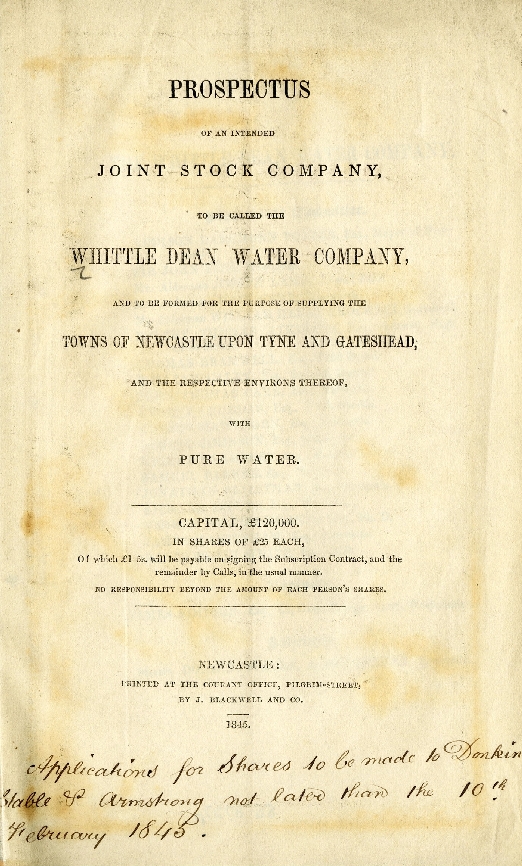
[White (Robert) Collection, W942.8 WHI]
Robert Spence Watson, the local reformer, politician and writer, and an associate of Armstrong, remarked that, by this period, the local papers of the day referred to Armstrong as “Our talented young townsman”.4 Indeed, just a few years after the establishment of the Elswick Works he was held in high esteem in engineering and industry circles, attending important events and fraternising with other prominent local figures.
A list of toasts from a dinner held for the Chairman of the Coal Trade, held at the Assembly Rooms in Newcastle on 22nd October 1850, shows that Armstrong was in attendance at the event and was given the honour of addressing one of the after-dinner toasts, to the Railway Interest. Armstrong would have dined well that evening, for the dinner menu confirms this to have been a lavish affair, suggesting something of the lifestyle to which, by now, Armstrong would have been becoming accustomed.5
The Great Elswick Works
The newly-formed W.G. Armstrong & Co. began production at the Elswick Works on 1st October 1847. Their first order came from Jesse Hartley, the engineer at the Albert Dock in Liverpool and, as the hydraulic technology was adapted to other types of machinery, the business grew from strength to strength. The firm’s contracts included manufacturing hydraulic mining machinery for the lead mines at Allenheads in Northumberland and a hydraulic engine for operating the printing press at the Newcastle Daily Chronicle. 6
Orders were received from all over the country, and then from all over the world. The business evolved through many incarnations over the decades, continuing to manufacture hydraulic machinery but also entering the field of armament production and, later, ship building, becoming widely-known as “The Great Elswick Works”.
Elswick’s Early Days
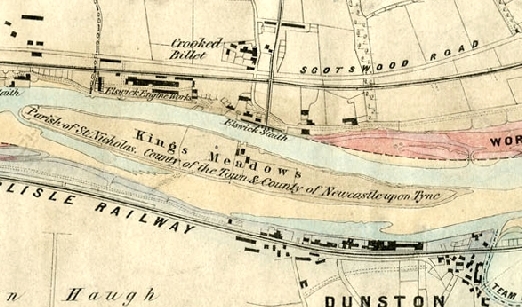
[Maps Collection]
This detail from a map dated 1849 shows the Elswick Works two years after their establishment. The Works were set in 5.5 acres of land on the estate of Elswick near to the village of Scotswood, just to the west of Newcastle.
At the time of the factory’s establishment the area was a spot of great natural beauty, encompassing green fields and open spaces leading down to the banks of the Tyne. The centre of the river opposite the works was occupied by King’s Meadows island upon which, amongst other things, was situated a public house, the Countess of Coventry.
Growth & Expansion
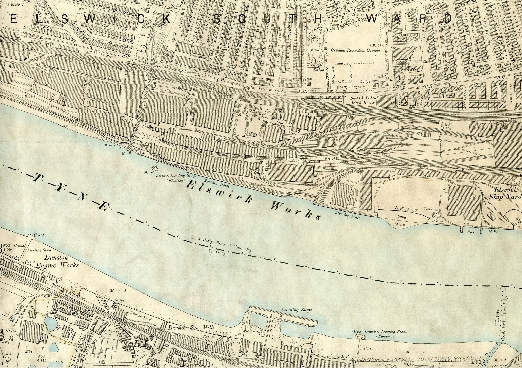
In this map from 1898, two years before Armstrong’s death and over fifty years since the Elswick Works were first founded, the expansion of the factory site can be clearly seen, along with its effects on the surrounding area, with the appearance of densely packed rows of workmen’s houses and the disappearance of King’s Meadows island, which was removed by the Tyne Commissioners to allow the passage of large ships to and from the Elswick Works and other factories.
The Armstrong Gun
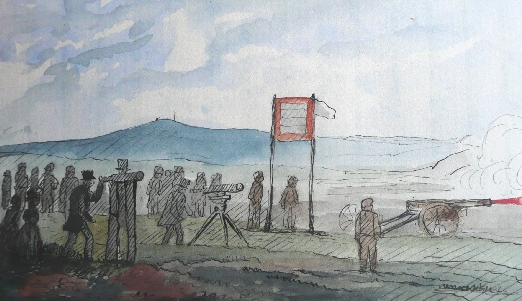
Used by kind permission of Mr Robert Sopwith.

Used by kind permission of Mr Robert Sopwith.
In the 1850s, Armstrong moved into the field of armament production when he developed a revolutionary new type of field gun in response to the high loss of life experienced during the Crimean War and was subsequently commissioned to supply the War Office with the new gun. The Armstrong Gun carried crucial innovations, including the ability to breech-load and the use of elongated lead projectiles instead of cast iron balls as ammunition.
Armstrong carried out the testing of his gun on the moors at Allenheads in Northumberland where his close friend and fellow engineer Thomas Sopwith was the chief agent for W.B. Lead Mines. Sopwith’s journal accounts (available on microfilm) are a valuable window onto some of the key events and moments in Armstrong’s life.
Of his friend Sopwith wrote:
“I have had many opportunities of witnessing his devotion to Science and his marvellous aptitude in adapting the power of natural forces to any required mechanical purpose”. 7
Sopwith’s journal includes an account of the Armstrong Gun Trials, and he accompanied his account with a lively watercolour sketch of the occasion.
International arms dealer
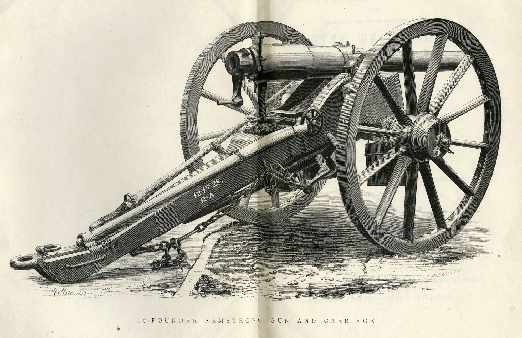
[Clarke (Edwin) Local Collection, Clarke 1807]
When in 1862 the government ended its contract with the Elswick Works, Armstrong went on to sell armaments indiscriminately to foreign countries. Although this seemed controversial to some, Armstrong felt justified in doing so. He reasoned that:
“it is in our province, as engineers, to make the forces of matter obedient to the will of man; and those who use the means we supply must be responsible for their legitimate application”.8
Many agreed and appreciated his achievements but Armstrong’s contribution to developing the tools of warfare would cast an inevitable shadow over his otherwise bright memory. Upon his death in 1900, the Newcastle Daily Chronicle remarked:
“There is something that appals the imagination in the application of a cool and temperate mind like Lord Armstrong’s to the science of destruction.” 9
Although later in its existence Armstrong took less of a personal involvement in the day-to-day running of the business, he was fiercely proud of the Elswick Works and what he had achieved there. During the visit of the Prince and Princess of Wales to Newcastle in 1884 he stated that:
“an inspection of our places of industry which omits a view of the Elswick Works is rather like the play of Hamlet, with the part of the prince left out”.10
Armstrong the employer
As the business flourished and grew, Armstrong became an important employer on Tyneside. He took his responsibilities as an employer seriously and concerned himself with the welfare of his workers, founding a Literary and Mechanics Institute for them as well as a school. However, workers at Elswick joined with workers from other factories in the Nine Hours’ Strike in 1871, campaigning for a shorter working day. In common with other employers, Armstrong took a firm stance against the striking workers, and was viewed by many as being a cold, remote figure who was out of touch with his workers.
In a pamphlet published by the Nine Hours’ Movement, which details the dialogue between the employers, represented by Armstrong, and their workers during the strike, some of Armstrong’s letters to the workers are reprinted in full. In one such letter, Armstrong wrote:
“However desirable a reduction in the hours of labour may be, the decision of the question must rest on commercial, and not sentimental considerations.” 11
Engineering Triumphs

In 1876 the river passage was opened up further when the River Tyne Commissioners demolished the old stone bridge over the Tyne, which had been too low to allow the passage of large ships, and replaced it with a swing bridge which could pivot around on a central pier to provide access for ships when required. The mechanism was powered by Armstrong’s own hydraulic technology and, despite the bridge weighing 1450 tons, was reported in a contemporary account to move around “as quietly and apparently as easily as a parlour door upon its hinges” and was described as being “one of the sights of Newcastle.” 12
The guns manufactured at Elswick gradually grew in size, and eventually were large enough to arm war ships. A defining moment in the history of the Elswick Works, and one which confirmed its greatness, was the shipping of one of Elswick’s immense 100-ton guns from Elswick to Italy on the Italian ship Europa in 1876. The ship was the first vessel to pass through the channel of the new swing bridge, which in turn was the first bridge of its type in the world.
The ship was carrying the largest gun in the world which, upon its arrival in Italy, was hoisted by an Elswick-manufactured 180-ton hydraulic crane, the largest in the world of its type.
Princely Gifts
As Armstrong amassed great wealth from his engineering successes, he became a great benefactor to his native Newcastle. His contributions, however, were not just financial, for he also applied his ideas and expertise, and donated his time and effort, for the greater good of the inhabitants not only of his native Newcastle, but also of the North East region and beyond.
Saviour of Hartley Steam Coals
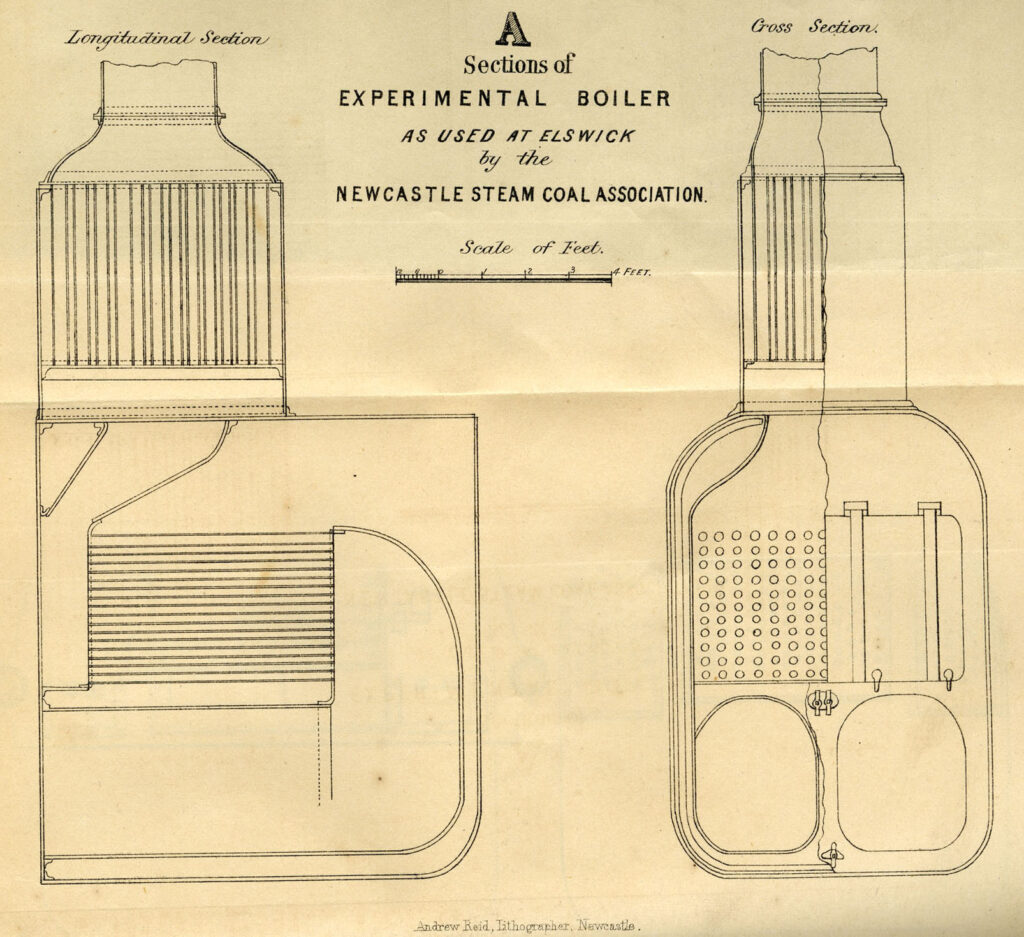
When in 1854 the British Government opted to cease using coal mined at Hartley in Northumberland for powering its naval ships in favour of Welsh coal, on the grounds that Hartley coal produced too much smoke, Armstrong was instrumental in investigating and disproving these claims.
He formed part of a three-man team in charge of awarding a £500 premium offered by the Steam Collieries Association of Newcastle for the best method of preventing smoke in the combustion of the coal. The experiments carried out in the process proved effective methods for eliminating smoke entirely and the results were published in a series of three reports published from 1857-58. The reputation of Hartley coal was thus saved, which carried significant implications for the local economy at a time when the British Empire was expanding and the merchant steam navies along with it. 13
Jesmond Dene
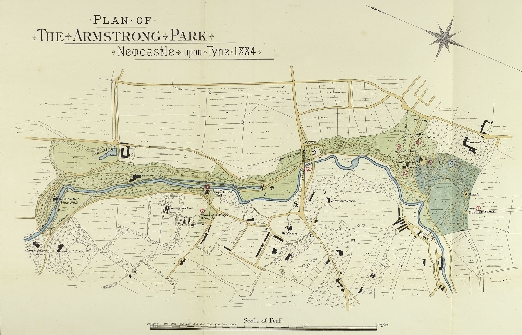
[Clarke (Edwin) Local Collection, Clarke 444]
In 1880, Armstrong presented the landscaped park of Jesmond Dene as a gift for the benefit of the inhabitants of Newcastle, with an additional gift of land in 1883.
The park, known initially as Armstrong Park, was officially opened by the Prince and Princess of Wales during their visit to Newcastle in 1884. A special volume was published to commemorate the royal visit, carrying a striking coloured plan of the park and bearing a dedication to Armstrong in gratitude for his “princely gifts” to the town’s inhabitants.
Deserving Causes
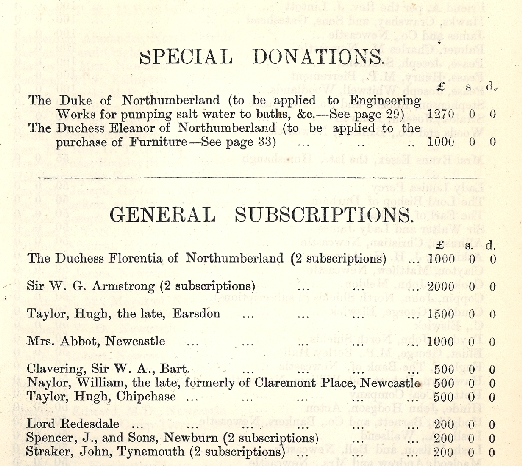
[Hospital Archives 12]
Armstrong made numerous and generous financial donations to charitable institutions in and around Newcastle, including the Northern Counties Institution for the Deaf and Dumb, the Hospital for Sick Children, The Royal Victoria Infirmary and the Prudhoe Memorial Convalescent Home. This subscription list for the Prudhoe Convalescent Home records a donation of £2000 made by Armstrong. In today’s money, this would amount to in the region of £100,000.
Lit & Phil
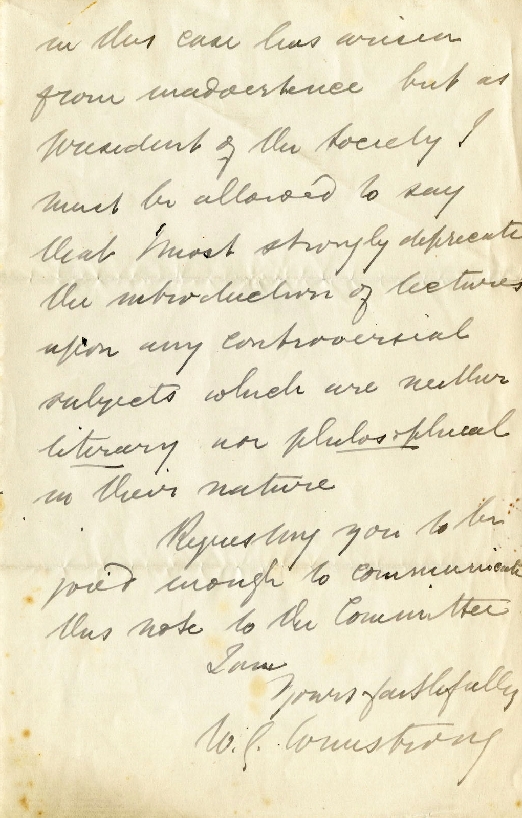
[Spence Watson/Weiss Archive, SW 1/1/7]
In 1859, Armstrong contributed £1200 (in the region of £50,000 in today’s money) for the construction of a new lecture theatre for the Lit & Phil Society in Newcastle. He, and his father before him, had had a long association with the Lit & Phil and he served as its President for many years. Given his generous contributions to the provision of its lecture facilities, it is perhaps not surprising that Armstrong held strong views on how they were used. In 1883 he wrote to the committee of the Society, expressing his displeasure at the subject matter of a recent lecture on an economic issue:
I am quite at a loss to understand how the Committee of the Society can have been induced to grant the use of the Lecture room for a discourse on such a subject as the “Unearned Increment”. It appears to me that they might just as well have permitted a lecture on the proper functions of the clergy, or on the disestablishment of the church, or on the progress of rationalism, none of such subjects would have been more calculated to stir up disaffection in the Society than that which has been countenanced by the Committee & expounded by an ecclesiastic member of the Society.
I would fain hope that the action of the Committee in this case has arisen from inadvertence but as President of the Society I must be allowed to say that I most strongly deprecate the introduction of lectures upon any controversial subjects which are neither literary nor philosophical in their nature. 14
College of Physical Science

[Manuscript Album, MAS/144]
Armstrong provided substantial financial and practical support towards the foundation in Newcastle of a College of Physical Science, ultimately to evolve into Newcastle University. He acted as Chairman for the College’s executive committee, made generous subscriptions to the College fund and put his influential name to the subscription appeal, winning the support of his fellow local industrialists.
Armstrong laid the foundation stone of the new college building in 1887 and ten years later he presented it with the equipment which he had used to conduct his experiments into electrical discharges; the valuable equipment formed the nucleus of the Electrical Laboratory in the Physics Department of the College. After his death in 1900, the college fund became the Armstrong Memorial Fund, and it was agreed to rename the college Armstrong College in his honour.
In this letter from Robert Spence Watson, who acted as the College’s legal advisor, to Armstrong, Spence Watson discusses with him matters relating to the purchase of lands for the College and the raising of subscriptions to the fund, in reply to a letter from Armstrong on the subject:
I have forwarded your letter to Professor Garnett & have asked him to write direct to you upon the subject. There can be no question that we have no money whatever to spend on speculation but if I understand the matter rightly we should be able at this site to have two acres for the price at which we could have one acre at the Singleton House site… We have not yet made any applications for subscriptions. We have one other promise of £1,000 as well as a promise of £50 a year but these have been made without any application being put out. The Council considered that we could not apply for subscriptions until we had definite plans to lay before the public. 15
In this letter from Robert Spence Watson, who acted as the College’s legal advisor, to Armstrong, Spence Watson discusses with him matters relating to the purchase of lands for the College and the raising of subscriptions to the fund, in reply to a letter from Armstrong on the subject:
“I have forwarded your letter to Professor Garnett & have asked him to write direct to you upon the subject. There can be no question that we have no money whatever to spend on speculation but if I understand the matter rightly we should be able at this site to have two acres for the price at which we could have one acre at the Singleton House site… We have not yet made any applications for subscriptions. We have one other promise of £1,000 as well as a promise of £50 a year but these have been made without any application being put out. The Council considered that we could not apply for subscriptions until we had definite plans to lay before the public.”15
Visions of the Future

[Clarke (Edwin) Local Collection, Clarke 1807]
Another important and enduring contribution made by Armstrong was through his ability to look ahead to the future, especially in relation to the efficient production and use of energy. His preoccupation with this area of concern, along with his pioneering work in the field of hydraulic and hydroelectric power, has resulted in him being a more significant figure than ever today.
During his inaugural address as President of the British Association for the Advancement of Science at its meeting in Newcastle in 1863, he spoke about the issue of finite coal reserves and the energy potential of solar power. This important lecture was reprinted the following year in the volume The Industrial Resources of the Tyne, Wear & Tees.
The 1887 Exhibition
At the Newcastle upon Tyne Royal Mining, Engineering and Industrial Exhibition, which was held in 1887 to celebrate Queen Victoria’s Golden Jubilee and to showcase Newcastle as “the Metropolis of the North of England”, one of the principal exhibits was a full-size model of a 110-ton Elswick gun, described in the exhibition guide as being “the largest gun ever made in this country and… the most powerful piece of ordnance in the world”.
The model was positioned so as immediately to face the visitor upon entering the exhibition hall and was considered the crowning glory of the exhibition.
East or West, Hame’s Best
In 1863, Armstrong purchased land near Rothbury in Northumberland and began there the construction of a country residence. His new home, Cragside, would become the place where he increasingly spent his time as he retired from the day-to-day running of the business. These later years of Armstrong’s life saw him indulge his passion for hydraulics and hydroelectric power, and re-kindle his old love-affair with electricity.
Cragside

Used by kind permission of Mr Robert Sopwith.

[Manuscript Album, MAS 147]
The construction of Cragside was completed by 1869. Its grounds were landscaped and five artificial lakes were created at a height to provide water pressure for the house’s water supply, generating electricity and powering the house’s hydraulic appliances which included lifts and a roasting-spit in the kitchen.
Cragside was the first house in the world to be lit using hydroelectric power and the first to be lit by Joseph Swan’s newly-invented incandescent light. It also played host to the Prince and Princess of Wales during their visit to the area in 1884, on which occasion Armstrong lit up the grounds with 10,000 small glass lights and a similar number of Chinese lanterns.
The mantelpiece above the huge fireplace in the dining room bore the motto “East or West, Hame’s Best”, conveying, perhaps, the extent to which Armstrong saw Cragside as a place of comfort, contentment and retreat from the hectic life of running his business.
In this letter written by Joseph Swan, the inventor of the incandescent light bulb, to the local photographer and friend of Armstrong, John Worsnop, Swan recalls the installation of electric lighting at Cragside:
“Yes so far as I know his house at Cragside was the first house in England properly fitted with my electric lamps – I had greatly wished that it should be & when I told him so he readily assented. There had, previously to the introduction of the incandescent lamp into the house been an arc lamp in the picture gallery – that was taken down & my lamps were substituted, & it was a delightful experience for both of us when the gallery was first lit up.” 16
An old passion rekindled

These later years of Armstrong’s life saw his love-affair with electricity re-surface. He reprised his earlier lectures on electricity when he delivered a lecture and demonstration to the Lit & Phil, to mark its centenary in February 1893, on the novel effects of the electric discharge. During the lecture he made reference to his thirty-year tenure of the Presidency of the Society and recalled his demonstration of his hydroelectric machine forty-nine years earlier. In this letter from Armstrong to Robert Spence Watson, written the previous month, Armstrong is seemingly gathering facts for inclusion in the lecture:
“I dare say that from your knowledge of the history of the Lit & Phil you can readily tell me what was the date of my lecture to the Society on the electricity of steam & also the date of the lecture at which I exhibited a model of the hydraulic crane. Please also tell me at which date I was first elected President of the Society“. 17

[19th Century Collection, 19th C. Coll 537 ARM]
Further experimentation with electricity led to Armstrong’s publication of the volume Electric Movement in Air and Water, containing a set of striking photographic images of electric discharges taken by the Rothbury-based photographer and friend of Armstrong John Worsnop.
A Life of Achievement
Armstrong was raised to the peerage as Baron Armstrong of Cragside in June 1887. In this photograph, taken by John Worsnop in c. 1897, Armstrong appears to be content, satisfied and self-assured, understandably so when the sheer scope and significance of his achievements is considered.
Armstrong died at Cragside on 27th December 1900, and was remembered as having been a towering figure of the Victorian era.
Notes
1. Whittle Dean Water Company.Prospectus of an intended joint stock company to be called the Whittle Dean Water Company(Newcastle: Courant Office, 1845).
2. FARNE (Folk Archive Resource North East) http://www.folknortheast.com
(accessed 10/09/2010)
3. Extract from “The ‘Lectric Leet” in “Penny Song Book” (1851) in Selkirk’s Collection of Songs and Ballads for the people, original and select (1853)
4. Spence Watson, R.The history of the Literary and Philosophical Society of Newcastle-upon-Tyne (1793-1896). (London: W. Scott, 1897), p.171
5. Available in Bell Material/ Port of Tyne Collection, Box 3
6. McKenzie, P. W. G. Armstrong: the life and times of Sir William George Armstrong, Baron Armstrong of Cragside. ([S.l.]: Longhirst Press, 1983). p. 44
7. Journal of Thomas Sopwith, 30th January 1859 (used by kind permission of Robert Sopwith).
8. Dougan, D. The Great Gun-Maker: the story of Lord Armstrong. (Newcastle upon Tyne: Graham, [1970]). p. 67
9. Dougan, D. The Great Gun-Maker: the story of Lord Armstrong. (Newcastle upon Tyne: Graham, [1970]). p. 69
10. Record of the Visit of Their Royal Highnesses the Prince and Princess of Wales to Newcastle-upon-Tyne, August 1884 (Newcastle upon Tyne, 1885).
11. Burnett, J. Nine hours’ movement: a history of the engineers’ strike in Newcastle and Gateshead (Newcastle upon Tyne, J.W. Swanston, 1872).
12. Newcastle upon Tyne Royal mining, engineering and industrial exhibition. (International and colonial.) Jubilee year 1887: Official catalogue. Bound with other exhibition publications. (Newcastle upon Tyne: R. Robinson, 1887).
13. McKenzie, p. 67
14. Letter from W.G. Armstrong to Robert Spence Watson, 31 May 1883.
Spence Watson/Weiss Archive, SW 1/1/7
15. Letter from Robert Spence Watson to W.G. Armstrong, 17 April 1886.
Manuscript Album, MSA 144
16. Letter from Joseph Swan to John Worsnop, 9 November 1897.
Manuscript Album, MSA 147
17. Letter from W.G. Armstrong to Robert Spence Watson, 16 January 1893.
Spence Watson/Weiss Archive, SW 1/1/9
Bibliography
Armstrong, W.G. Experimental lecture by the Right Hon. Lord Armstrong on novel effects of the electric discharge. Delivered to the Literary and Philosophical Society, Newcastle-on-Tyne, at its centenary celebration February, 1893.
(Newcastle upon Tyne. Printed by Richard Mayne, 1893]
Allen, E., Clarke, J.F., McCord, N. & Rowe, D.J. The North-East engineers’ strikes of 1871: the Nine Hours’ League
(Newcastle upon Tyne, Graham, 1971)
Dougan, D. The Great Gun-Maker: the story of Lord Armstrong
(Newcastle upon Tyne: Graham, [1970])
FARNE Folk Archive Resource North East)
(accessed 10/09/2010)
Fraser, C.M. An outline history of the Newcastle Division of the University of Durham.
Part I: The Genesis of the Durham College of Physical Science
(printed for private circulation, 1961).
Gurney, H.P. “Memoir of the Late Lord Armstrong” in Transactions of the Institute of Mining Engineers, Vol. XXI, 1900-1901 (1903)
Heald, H.William Armstrong: Magician of the North
(Newcastle upon Tyne: Northumbria Press, 2010)
Linsley, S.M. Entry for Armstrong, William George, Baron Armstrong (1810-1900) in the Oxford Dictionary of National Biography
(accessed 25/01/2010)
McCord, N. North East England: an economic and social history
(London, Batsford Academic, 1979)
McKenzie, P. W. G. Armstrong: the life and times of Sir William George Armstrong, Baron Armstrong of Cragside
([S.l.]: Longhirst Press, 1983)
Richardson, B. Thomas Sopwith: with excerpts from his diary of fifty-seven years
(London: Longmans, Green, 1891)
Smith, K. Emperor of Industry: Lord Armstrong of Cragside
(Newcastle upon Tyne, Tyne Bridge Publishing,2005)
Spence Watson, R.The history of the Literary and Philosophical Society of Newcastle-upon-Tyne (1793-1896)
(London: W. Scott, 1897)
Warren, K. Armstrong’s of Elswick: growth in engineering and armaments to the merger with Vickers
(London, Macmillan, 1989)
